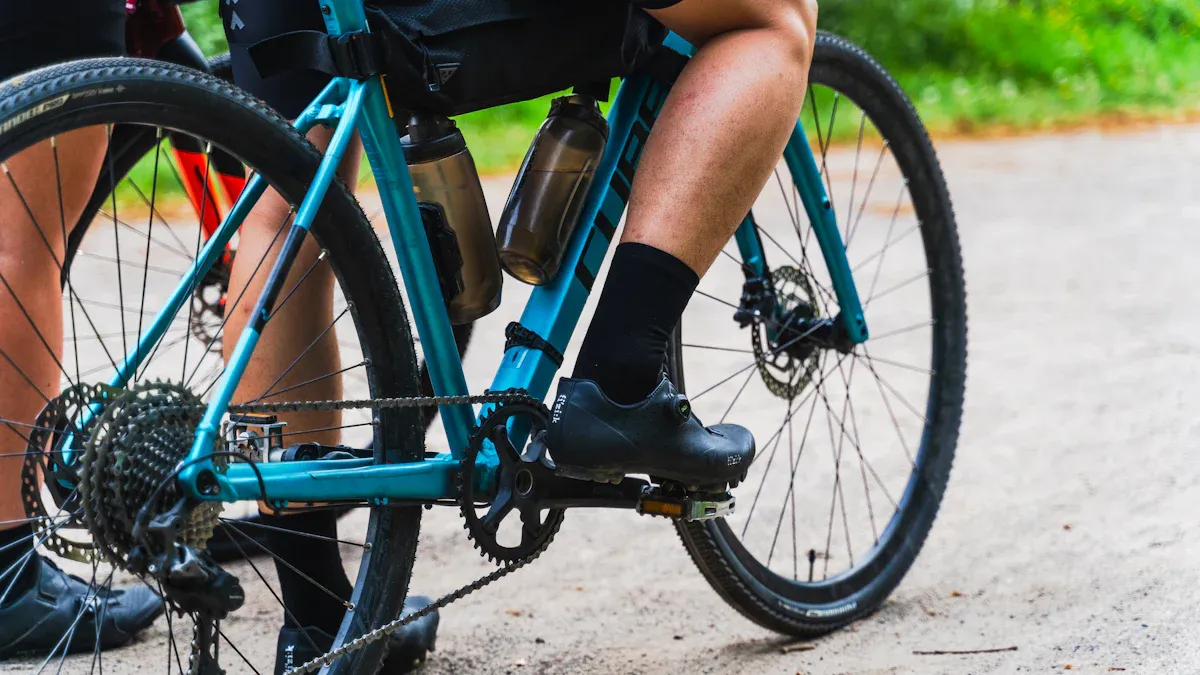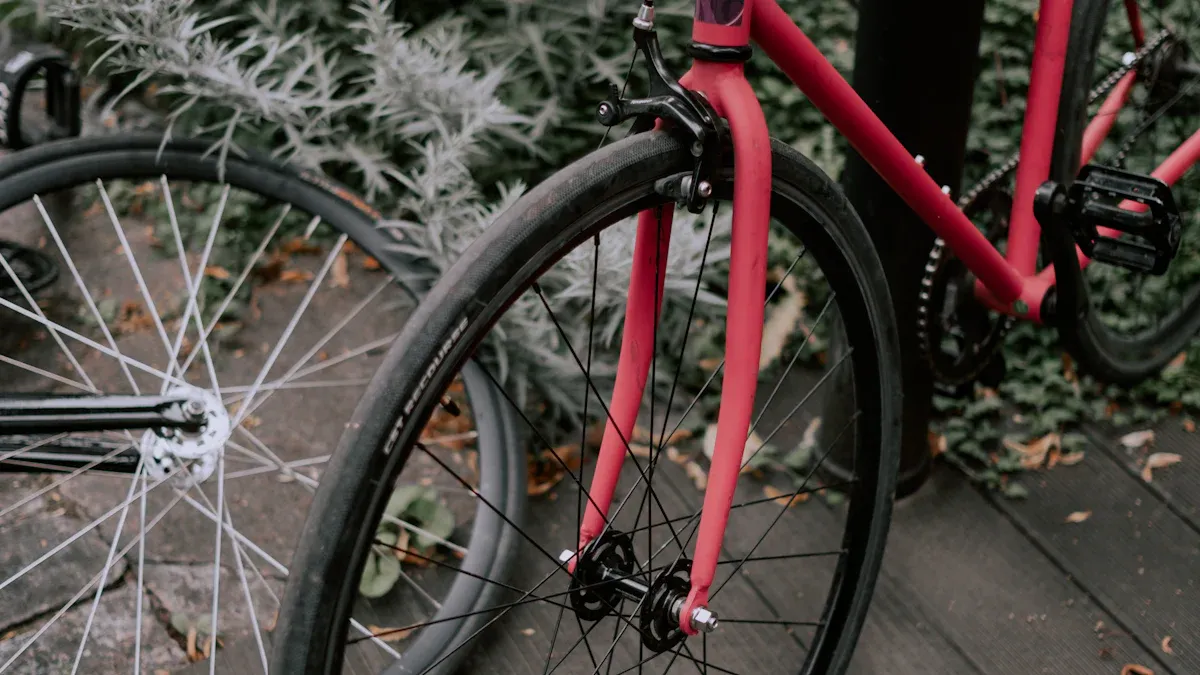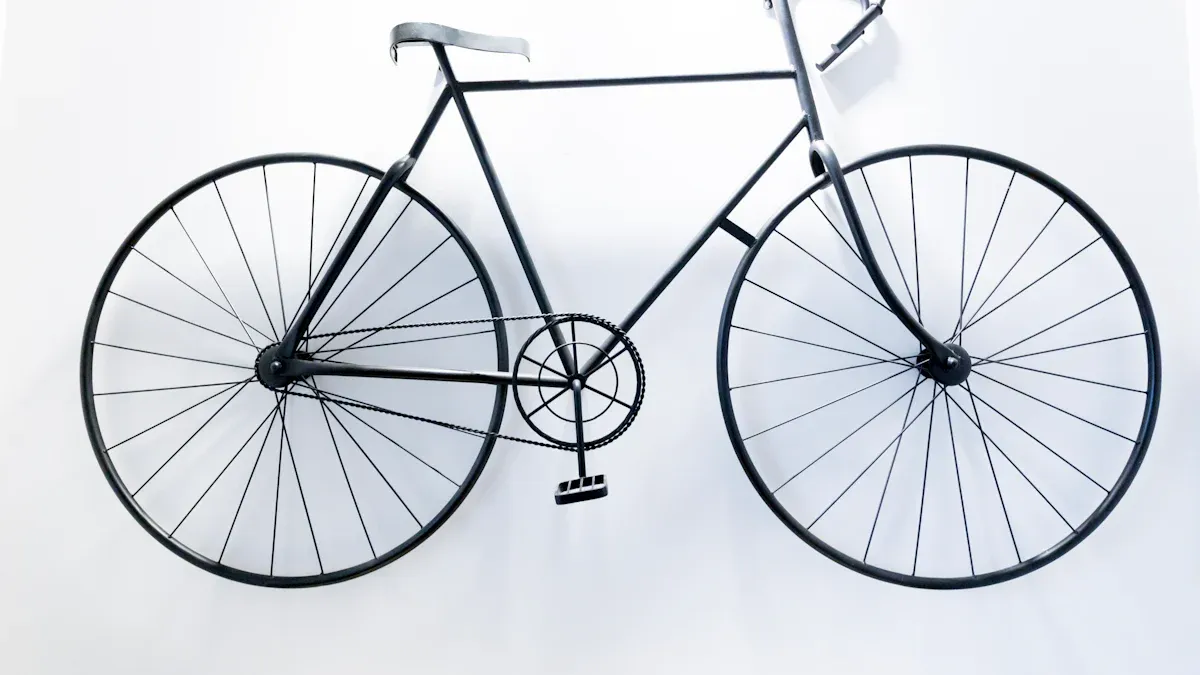
Choosing the right MTB frame gravel bike is very important. It can really improve how well you ride, how comfortable you feel, and your whole biking experience. A good MTB frame gravel bike has a mix of strength, stability, and lightness. Studies show that things like seat tube angles can change your posture. This affects how comfortable you are while riding. For example, steeper angles help you use energy better. This means you can ride longer without getting tired. So, when you are out gravel biking, remember that the right MTB frame gravel bike matters a lot!
Key Takeaways
Pick the best frame material. Alloy frames are tough and cheap. Carbon frames are lighter and help you ride better.
Know bike shape. Important sizes like stack, reach, and head tube angle change how comfy and in control you feel while riding.
Check tire space. A gravel bike needs to fit wider tires. This helps you handle different surfaces better.
Think about gear mounting options. This makes your rides more useful and improves your biking fun.
Get the right size. Measure your reach and stack. This helps you avoid pain and injuries while riding.
Frame Materials for Gravel Bikes

Choosing the right frame for your gravel bike is very important. The material you pick matters a lot. You usually have two main choices: alloy and carbon. Each type has its own pros and cons that can change how you ride.
Alloy vs. Carbon
They are usually heavier than carbon frames. This can be felt during steep climbs or long rides.
They are known for being strong and affordable. This makes them a favorite for many riders.
Aluminum is expected to take over the gravel bike frame market with 51.3% share by 2025. This is because it is light and strong, which is great for gravel biking.
Carbon Frames:
They are lighter and stiffer. This helps improve your performance and comfort on bumpy roads.
They reduce vibrations better. This lets you ride longer without getting tired.
Many top gravel racers like carbon frames for their lightness and stiffness. This can really help with speed and control.
Durability and Affordability
When thinking about durability and cost, here’s what to remember:
Durability:
Alloy frames are strong. They can handle rough rides well. They are less likely to get damaged from hits compared to carbon frames.
Carbon frames are lighter and better for performance. But they can break more easily from crashes or hard hits. Still, they often come with warranties for these problems.
Affordability:
If you need to save money, alloy frames are usually the best choice. They give good value without losing much performance.
Carbon frames are often more expensive. But they can really boost performance, especially for serious riders wanting the best gravel bikes.
Gravel Bike Geometry Essentials

When you pick an MTB frame for your gravel bike, knowing about geometry is very important. The geometry affects how your bike rides, how comfy you feel, and how well you handle different surfaces. A good gravel bike geometry can make your rides smoother and more fun.
Key Geometry Features
There are several key geometry features that set apart MTB frames made for gravel bikes. These features help with stability at high speeds and improve handling on loose ground. Here are some important things to think about:
Fork Rake and Trail: These measurements change how the bike steers. A longer rake gives better stability. A shorter rake allows for quicker turns.
Wheelbase: A longer wheelbase usually gives more stability, especially when going downhill or on rough paths.
Front-Centre: This measurement affects how weight is spread out. A balanced front-centre helps keep control when going down hills.
Bottom Bracket Height: A higher bottom bracket helps clear obstacles. A lower one can make the bike feel more stable.
These geometry features work together to make a bike that feels steady and comfy, especially on gravel.
Impact on Comfort
The right gravel bike geometry can really affect your comfort on long rides. Here are some ways geometry matters:
Chainstay Length: The length of the chainstays changes how the bike handles. Shorter stays make the bike feel more agile. Longer stays help with stability, which is key for control on bumpy ground.
Head Tube Angle: A slacker head tube angle helps with stability, especially at high speeds on loose surfaces. This angle makes you feel safer when riding on tricky paths.
Feature | Effect on Handling |
|---|---|
Chainstay Length | Shorter stays make handling quicker; longer stays improve stability. |
Head Tube Angle | Slacker angles help with stability, especially at high speeds on loose ground. |
Also, frame compliance has gotten better because of design changes, not just materials. This means geometry can affect comfort by allowing flex in certain areas, like the seat tube. How well you ride is closely linked to how vibrations reach you. A well-designed gravel bike frame can soak up bumps better, making your ride more enjoyable.
MTB Frame Fit and Sizing
Getting the right fit for your MTB frame gravel bike is very important. A bike that fits you well makes riding fun. But a bike that doesn’t fit can cause pain and injuries. Let’s look at how to measure for the right fit and what to think about for stem length.
Measuring for the Right Fit
To make sure your gravel bike frame fits you just right, pay attention to a few key measurements. Here’s what to think about:
Reach: This is how far it is from the bottom bracket to the head tube. It helps you know how much you lean forward when riding.
Stack: This is the height from the bottom bracket to the head tube. It changes how high your handlebars are and how you sit.
To get these measurements, follow these steps:
Measure the reach from the bottom bracket to where your hands go.
Find the stack by measuring the height from the bottom bracket to the handlebars.
Adjust your new bike to match these stack and reach numbers.
If you have the same pedals and crank length, use your saddle height as is.
For saddle setback, measure from the back of the saddle to your hand position after setting stack, reach, and saddle height.
Remember, riding a bike that doesn’t fit can ruin your fun. A bike that’s too big can stretch you too much. A bike that’s too small can make you cramp. Both can lead to injuries like pulled muscles and strained ligaments from being out of line.
Stem Length Considerations
Stem length is very important for getting your fit right on a gravel bike. It changes where the handlebars are compared to the saddle. This affects how your upper body sits. Here are some things to remember:
Longer stems push you forward. This puts more weight on the front wheel and slows steering.
Shorter stems help you sit up straighter. This moves weight back to the rear wheel.
Choosing the right stem length can help you balance and feel comfy while riding. It also helps you use your power better, balancing speed with performance. If you’re not sure about your fit, think about talking to a professional bike fitter. They can help you adjust your setup for the best ride.
Making Gravel Bike Buying Decisions
When you are ready to buy a gravel bike, think about how the parts fit together. Compatibility is very important for your bike to work well. Here are some key things to remember:
Compatibility with Components
The different parts of your bike need to work well together. Here’s a quick look at some compatibility factors:
Compatibility Factor | Description |
|---|---|
Wheel Diameter | Different bike types use different wheel sizes. This affects how they fit with MTB frames. |
Tyre Clearance | You need enough space to avoid rubbing. This is especially important for wider tyres. |
Freehub Type | The freehub must match the drivetrain. This is needed for good performance. |
Axle Type and Sizing | Correct axle sizes are important for fitting wheels to the frame and fork. |
If you want to change an MTB into a gravel bike, think about these compatibility issues. Make sure your new gravel bike frame can fit the parts you already have or want to buy.
Personal Riding Style
Your riding style is very important when picking a frame. If you like to ride aggressively on tough trails, you might want a stiffer MTB frame. This type helps with control and quick responses, making it easier to handle tricky paths. But if you prefer longer, easier rides, a gravel bike frame might be better. These frames focus on comfort and stability, so you can enjoy long rides without feeling uncomfortable.
Choosing the right frame size is also very important. A mountain bike that is too big can make it hard to turn. A bike that is too small can cause handling problems. This is especially important if you like to ride on challenging terrains. You want a bike that feels just right, so you can enjoy your ride without worrying about discomfort or getting hurt.
Choosing the right MTB frame for your gravel bike is very important for a fun ride. Here are some key things to think about:
Material: Think about choices like carbon fiber, aluminum, and steel. Each one changes how your bike performs and feels.
Geometry: Check the stack height, reach, and head tube angle. These parts affect your comfort and how you control the bike.
Tire Clearance: Make sure your bike can fit wider tires. This helps you ride on different surfaces.
Mounting Options: Consider how you will carry extra gear. This makes your rides more practical.
Remember, don’t make mistakes like buying a bike that’s too big or only thinking about the bike without planning for gear. Always consider your riding style and how it might change later. Enjoy biking! 🚴♂️
FAQ
What’s the difference between MTB frames and gravel-specific frames?
MTB frames are built to be strong and handle rough paths. Gravel frames are made for comfort and stability on long rides over different surfaces. If you ride hard, an MTB frame might be better for you. For longer and smoother rides, think about a gravel frame.
Can I convert my MTB into a gravel bike?
Yes, you can change your MTB into a gravel bike! Just make sure the frame can fit wider tires and has the right spots for gear. Check that the parts like the drivetrain and wheel size work well together for an easy change.
How do I know if my MTB frame fits me?
To find the right fit, measure your reach and stack. Adjust your saddle height and how far back it sits. If you’re not sure, ask a professional bike fitter. A good fit makes your rides more comfortable and helps you perform better.
What should I consider for component compatibility?
When picking parts, check the wheel size, tire space, and axle type. Make sure your new parts match your frame. This compatibility helps your bike work well and gives you a smooth ride.
Are alloy frames better for beginners?
Alloy frames are usually a good choice for beginners. They are strong and affordable without losing much performance. Their durability makes them great for rough trails while you learn and gain confidence.
See Also
Selecting The Ideal Bike Frame Based On Your Requirements
Key Factors To Evaluate When Picking An E-Mountain Bike Frame
Professional Tips For Selecting The Best Carbon Mountain Bike Frame
Finding The Best Step Through Frame Bike For Your Preferences
Determining The Best Aluminum Road Bike Frame For Your Style
